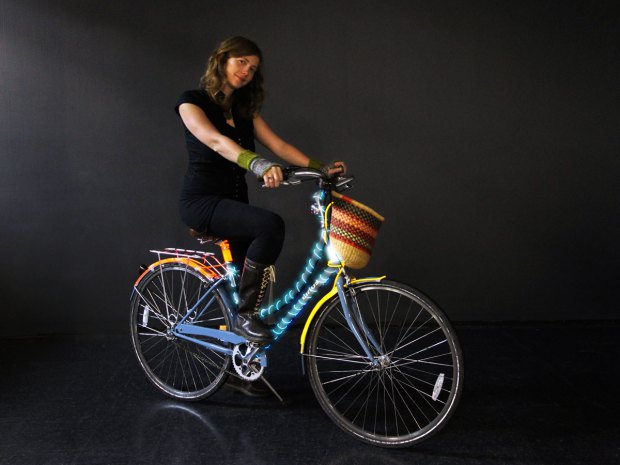This project first appeared in MAKE Volume 38, on pages 68-71.
Bike lights and reflective tape are the common go-to’s for night riding, but why not go further and make your bicycle frame glow? About three years ago, Vancouver Hack Space member Luke Closs decided to put electroluminescent wire (EL wire) on his bike, mostly because he thought it would look cool — but also for the added benefit of bicycle visibility.
After making a few prototype kits, Luke decided he wanted to see hundreds of Glow Bikes in the city. I put together an EL wire kit and discovered it was a great introduction to soldering. So as Luke assembled kits, I took photos and compiled an instruction manual. These prepared materials helped us simplify “build nights” and get large groups of people to mod their bicycles together. At the end of this project, we sold over 100 bike kits!
Back then, soldering your own inverter to the EL was the only way to make it glow. Now there are lots of plug-and-play options, like the EL Wire Starter Pack we’ll use here. (There are even fancy splitters so you can have 4 wires powered from the same driver!) Even though it takes a bit of time and effort to solder your own EL, it’s a valuable skill — once I understood how to solder EL to a driver, I also knew how to fix it. It’s always good to “open up the box.”
With the Starter Pack kit, you can wrap your bike in glowing EL wire in minutes — but what if you want the glow to cross over to your handlebars, front fork, a bike trailer, or any other part of the bike that flexes? EL wire doesn’t like to flex, so we’ll show you how to splice EL wire to ordinary wire, to make clean bends in your design. Want an even brighter show? We’ll show you how to add a more powerful driver that also has the ability to respond to sound.
I encourage you to make your own Glow Bike and tell your friends as well. It’s rewarding and it’s sure to turn a lot of heads.
What Is EL Wire?
Electroluminescent wire consists of a copper wire coated in phosphor (a luminescent substance similar to what’s in glow-in-the-dark toys), which glows when an alternating current is applied across it by outer wrap wires (aka “angel-hair” wires).
Tips on Batteries and Drivers
This project uses readymade driver kits, but when you tackle bigger projects you’ll want to use more powerful EL wire drivers. You have several battery options depending on your skill level and requirements. EL wire drivers will accept 9V–12V, but your EL will be much brighter with a full 12V.
- Alkaline batteries provide 1.5V, so 8 of them yield 12V. Ikea’s AA batteries are very cheap and super fresh, so they last a long time!
- Rechargeable NiMH batteries provide 1.2V or 1.3V, so they’ll work but they won’t be as bright, or you’ll need 10 of the 1.2V type.
- Rechargeable alkaline batteries (such as Pure Energy brand) give 1.5V, are lighter than NiMH, and have no heavy metals.
- Lead-acid 12V batteries are heavy, but have a huge capacity and are very rechargeable.
- LiPo R/C helicopter batteries are very light, but expensive. Get a 14.4V LiPo pack and use a voltage regulator to knock it down to 12V.




